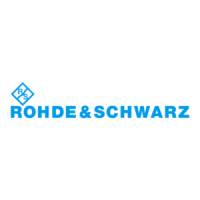GUI reference
R&S
®
ZNA
405User Manual 1178.6462.02 ─ 20
Resolution Enh.
Broadens the frequency range that the analyzer considers for the time domain trans-
form by a linear factor. A factor of 1 means that the original sweep range and the mea-
sured sweep points are used; no additional assumptions are made. With higher resolu-
tion enhancement factors, the measurement data is extrapolated using a linear predic-
tion method. As a result, the resolution in time domain can be improved.
The ideal resolution enhancement factor depends on the properties of the DUT. For
distance to fault measurements on cables, set it to 1.
Remote command:
CALCulate<Chn>:TRANsform:TIME:RESolution:EFACtor
TD-VSWR
Enables time domain site VSWR measurements (see Chapter 4.7.2.6, "Time domain
S
VSWR
measurements", on page 226).
Remote command:
CALCulate:TDVSwr[:STATe]
Gate Span
Time domain S
VSWR
measurements relies on a time gate that is centered at the anten-
na's direct response (plus ring-down time), separating the direct response from the
indirect responses (reflections).
"Gate Span" is equivalent to the "Span" value on the Time Gate tab.
This button is only enabled if TD-VSWR is active.
Remote command:
CALCulate<Chn>:FILTer[:GATE]:TIME:SPAN
Show Impulse Response...
To get an impression of the required Gate Span, you can quickly create a trace display-
ing the impulse response of the active trace in a new diagram.
This button is only enabled if TD-VSWR is active.
5.5.5.2 Low Pass Settings dialog
The "Low Pass Settings" dialog defines the harmonic grid for low pass time domain
transforms.
Access: Trace – [Trace Config] > "Time Domain" > "Low Pass Settings..."
Background information
Refer to Chapter 4.7.2.4, "Harmonic grid", on page 223.
Traces softtool

